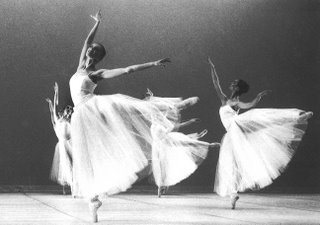United Ukrainian Ballet visits the Kennedy Center with new "Giselle"

Russia launched its unprovoked invasion of Ukraine almost one year ago, on February 24, 2022. In the wake of these barbaric attacks on cities and infrastructure, ballet dancers and ballet students fled Ukraine, along with many of their fellow citizens. Many of those dancers ended up in The Hague in the Netherlands, where they formed the United Ukrainian Ballet under the leadership of the Dutch dancer Igone de Jongh. (The male dancers joined later, since they were at first not allowed to leave Ukraine and avoid military service.) This ersatz company has toured the Netherlands and taken longer trips to London and Asia. They arrived at the Kennedy Center Opera House Wednesday night for a week-long run of the striking new version of Giselle choreographed by Alexei Ratmansky, their first and so far only planned appearance in the United States.
This Giselle is the product of Ratmansky's historical research, the latest ballet to be given the choreographer's archival scouring treatment, and it emerges like a ceiling fresco with centuries of soot and grime removed. Ratmansky first premiered the new version at the Bolshoi in 2019, and now it has put him on the edges of the subsequent Russian conflict with Ukraine. (Ratmansky grew up partially in Ukraine and had already moved his family to New York: the Russian attack last year propelled him to cut all ties with Russian companies. In a related story, one of the stars of his Giselle at the Bolshoi, celebrated étoile Olga Smirnova, resigned from that company and went to the Dutch National Ballet in Amsterdam, making prominent public statements against the war.)
As detailed in the authoritative program notes for the Kennedy Center, by dance critic Alastair Macaulay, Ratmansky has gone back to as many historical sources as he could find to restore many details from the original 1841 production, although he also preserves some of the Petipa additions found in Russian productions. Some of the patches are sections of music and action that were excised over the years: the original opening of Act II, where a group of men are drinking in the forest, only to be scared away by the Wilis; and in the middle of Act II, he has restored a fugue, depicting the confusion of the Wilis when their target, Albert, hides by the cross over Giselle's grave.
By looking closely at early sources, Ratmansky's version makes important changes to many of the pantomimed scenes, shifting the nature of most of the characters. The Giselle of Odessa-born Christine Shevchenko, who comes from American Ballet Theater to join the Ukrainian company for this run at the Kennedy Center, seems less fragile and more girlish. The extraordinary Albert of Oleksei Tiutiunnyk, a tall dancer of immense strength and leaping height, seems more genuinely in love with Giselle. Significantly, in a more hopeful ending, he heeds Giselle's last command, as she sinks back into the earth, to wed the noblewoman to whom he was betrothed. Even his fiancée, Bathilde (Marta Zabirynnyk), and the hapless woodsman who also wants to marry Giselle, Hilarion (Sergii Kliachin), become more sympathetic.

Ratmansky's research into the details of dance movement and even the tempos of the music also yield many surprises, especially in the movements of the corps de ballet in the more rustic Act I peasant dance, where Maria Shupilova and Vladislav Bondar made a favorable impression in the pas de deux. (The corps seemed a little rough and nervous on opening night, including one dancer who slipped and fell, but the personal situation these dancers face after fleeing their home country surely explains some of the agitation.) The addition of a "flying Wili," who floated by on wires at the back of the stage a couple times, was another surprise.
Sets and costumes, designed by Hayden Griffin and Peter Farmer (on loan to the Ukrainians from Birmingham Royal Ballet), were handsome, especially the purple-infused scene of the eerie night forest in Act II (lighting by Andrew Ellis). Elizaveta Gogidze, one of the Ukrainian stars (she will take the title role at the remaining evening performances), was a frigid fright as Myrtha, queen of the Wilis, assisted by fine performances from Veronika Hordina and Daria Manoilo. Viktor Oliynyk conducted the Kennedy Center Opera House Orchestra in the transformed score, with some misalignments that will likely be ironed out in the remaining performances.
Given the personal tragedy of these Ukrainian dancers and the public criticism of the Russian invasion made by Ratmansky, the curtain call was a stirring moment. The two lead dancers appeared with a Ukrainian flag. Ratmansky himself and other dancers brought on other flags. The Dutch company's artistic director, Igone de Jongh, took a bow but then left the stage before a rousing rendition from the orchestra of the Ukrainian national anthem. With the news that Russia is reportedly planning a new offensive in Ukraine, possibly coinciding with the February 24 anniversary, the message of support for Ukraine is all the more urgent.
Giselle runs through February 5. kennedy-center.org



























































